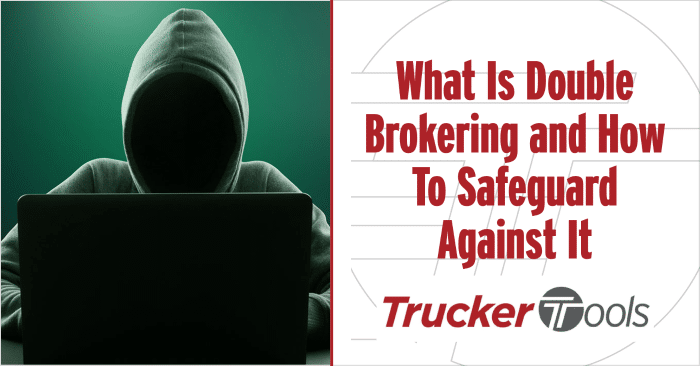Double brokering, which often involves thieves using fake motor carrier numbers, violates several different state and federal laws, leaving freight brokers, logistics companies and/or carriers on the hook for thousands of dollars. Unfortunately, double brokering in recent years has become increasingly common and a major point of concern for all sectors of the transportation industry. In a recent interview with FreightWaves, the Transportation Intermediaries Association’s Vice President of Government Affairs Chris Burroughs reported that double brokering may be impacting between $500 and $700 million in freight in the logistics and freight brokerage industries. Double brokering results not only in financial loss. The nefarious practice also can impact safety and long-term relationships between brokers and carriers.
Thankfully, there are steps that you can take as a freight broker or 3PL to safeguard against double brokering scams and fraudulent entities operating within the industry. The use of real-time technology can help you verify a carrier’s standing with the FMCSA and alert you of other red flags that may indicate that you’re encountering a double brokering scheme.
What Is Double Brokering
There is some confusion within the industry about what constitutes double brokering. Some confuse co-brokering with double brokering. Co-brokering is a legal practice in which a freight broker can sub-contract a load out to another licensed freight broker. Co-brokering is done with the knowledge and consent of all involved, including the shipper, you (the broker) and the carrier, which is why it’s a legal practice.
Double brokering, on the other hand, is an illegal practice in which scammers use a variety of tactics to trick freight brokers and 3PLs into believing they’re legitimate businesses. One of the most common double brokering tactics is to create multiple fake motor carrier numbers and pretend to have fleets of trucks to get loads from legitimate freight brokers and 3PLs. Once the broker or 3PL agrees to contract with the fake MC number, the scammers re-broker the freight to a legitimate carrier or owner operator at an extremely high rate, usually on a load board, to ensure it gets picked up and delivered. After the legitimate carrier picks up the load but before it is delivered, the scammers request quick payment. When the load is delivered, the carrier that actually transported the shipment is left high and dry.
Imagine another scenario in which a legitimate carrier ABC accepts a load from you, the freight broker or logistics provider. From there, carrier ABC brokers the actual transportation of the shipment to another legitimate carrier, carrier XYZ. The T.I.A. also considers this an instance of double brokering, as the shipper and you, the broker, have contracted with carrier ABC and are unaware that the shipment is actually being moved by a different carrier, carrier XYZ. It’s that lack of transparency and legitimate paperwork that makes such an arrangement illegal. Some brokers don’t even know that their freight has been double brokered until something bad happens with the load.
The Impact of Double Brokering
When your shippers’ loads are double brokered, you don’t know who is actually handling your shippers’ freight. It means that you no longer have control of your customers’ freight and that the freight is being exposed to liabilities and vulnerabilities to which your customers never agreed. You don’t know if the driver and truck transporting the load are properly licensed and/or properly insured. You also have no assurances about whether or not the carrier or driver is following safety rules and regulations and/or has the permits required to transport the load. If an accident occurs on a double brokered load, it may take months to sort out who is liable and you may be on the hook for damaged or stolen products.
When you encounter double brokering scammers, you may inadvertently pay the scammers via quick pay once the load is picked up, which leaves the carrier who actually moved the load and may be a legitimate business with no payment. Ultimately double brokering can negatively impact your company’s fiscal health and negatively impact your relationships with drivers, carriers and customers.
How To Safeguard Against Double Brokering
One of the best ways to safeguard against double brokering is to use technology that helps you verify a carrier’s identity. With Trucker Tools’ Smart Capacity, you can click on each carrier’s MC number in the platform to see if the MC number is active with the FMCSA. When you click on a carrier’s MC number in Smart Capacity, the link takes you to the carrier’s listing with the FMCSA. Be sure to examine the motor carrier’s information closely on the FMCSA’s website. If you see discrepancies between information listed for the MC number on the FMCSA’s website and the information that the carrier is giving you, this is a red flag. Obviously if the MC number is no longer active or has been suspended, that is a red flag, as well.

Another way to safeguard against double brokering is to use digital load tracking software and pay close attention to digital load tracking pings. If you get a location ping on an active load and the ping is nowhere near the geographic pickup location, you should be suspicious and consider this a possible double brokering red flag. Some scammers will accept the load tracking request and subsequent pings while pretending to transport the load, not realizing that once the track has started that you can see their GPS-based location. Other red flags that may indicate a double brokering scam include being offered a very low (or high) rate for a shipment, being told a load is a “blind load,” frequent address changes, demanding quick pay immediately, and/or a very new MC number.
If you do encounter double brokering, it’s important to report the incident to the proper authorities, including local law enforcement, the DOT and/or the Office of the Inspector General. It’s also recommended that you file a complaint with the FMCSA.
Read Trucker Tools’ new “State of the Freight Industry” report.
Schedule a free demo of Trucker Tools’ Smart Capacity and real-time load tracking platform.






